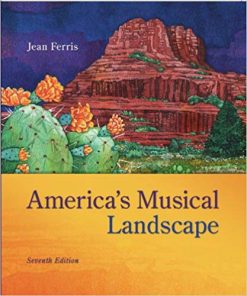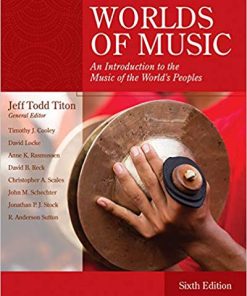The Test Bank for Music: The Art of Listening 9th Edition by Jean Ferris offers a complete collection of questions centered around the concept of melody. This test bank covers Chapter 03 and explores key concepts such as melodic structure, cadence, and various melodic forms. It is ideal for reinforcing knowledge of melody in music theory and understanding how melodies are structured and developed.
Sample Questions Include:
- Question 1: A melody is made up of one or more components known as:
A) Sequences
B) Sections
C) Cadences
D) Phrases - Question 2: The points that “punctuate” a melodic phrase are referred to as:
A) Pauses
B) Rests
C) Periods
D) Cadences - Question 3: The melodic structure of “Row, Row, Row Your Boat” is:
A) A A
B) A B - Question 4: The structure of the “Jingle Bells” refrain is:
A) A A B
B) A A B B’
C) A B A B’
D) A B A B - Question 5: What is the melodic structure of “Deck the Halls”?
A) A A B B
B) A A B B’ (modified)
C) A A B A
D) A A B A’ (modified) - Question 6: A written melody creates a linear pattern on the staff known as:
A) Curve
B) Contour
C) Angle
D) Line - Question 7: When the pitches of a melody lie close to one another on the staff, the melodic line is smooth or:
A) Conjunct
B) Disjunct
C) Lyrical
D) Vocal - Question 8: When the notes in a melody are far apart, the melodic line is described as:
A) Conjunct
B) Disjunct
C) Lyrical
D) Vocal - Question 9: A melodic and/or rhythmic pattern that is repeated many times is a(n):
A) Animato
B) Portato
C) Ostinato
D) Obligato - Question 10: An example of a melodic sequence occurs at the beginning of:
A) “Row, Row, Row Your Boat”
B) “Jingle Bells”
C) “Deck the Halls”
D) “Three Blind Mice”
Key Features:
- Focuses on melody and key concepts like cadence, melodic form, and conjunct vs. disjunct lines.
- Includes multiple-choice questions for testing your understanding of music theory.
- Instant download with no waiting time.
- Ideal for students studying music theory or music appreciation.
This test bank is perfect for reinforcing understanding of how melodies are constructed, recognizing different melodic patterns, and studying the relationship between melody and rhythm in music.













Reviews
There are no reviews yet.